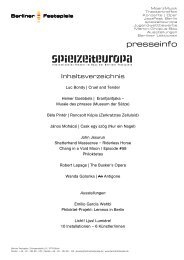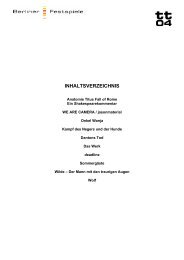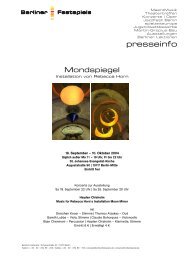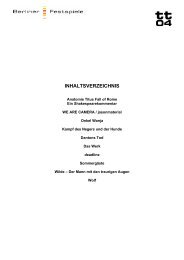konzerte04-pressemappe.pdf - Berliner Festspiele
konzerte04-pressemappe.pdf - Berliner Festspiele
konzerte04-pressemappe.pdf - Berliner Festspiele
Sie wollen auch ein ePaper? Erhöhen Sie die Reichweite Ihrer Titel.
YUMPU macht aus Druck-PDFs automatisch weboptimierte ePaper, die Google liebt.
een hitherto a general practice in pianoforte making to lay the strings or wires on the bridge of the<br />
sounding board with a pressure tending to press away the sound board, and it follows, that in course<br />
of time, the power of resistance which the sounding board is capable of opposing to that pressure<br />
of the wires upon it becomes lessened, and its power to produce free and pure vibrations reduced.<br />
These alterations from the original construction obviously prove injurious to the vibrations of the<br />
sounding board, and consequently tend to alter the quality of the tone of the instrument. In order to<br />
remedy such defect, I adopt a different principle of laying the wires on or against the sounding board,<br />
such principle consisting in making some of the wires or strings to press with a tendency to force the<br />
bridge in one direction, and an equal number of others to force the bridge in an opposite direction.<br />
And I would here state, that I am aware that it has before been proposed to have wires on either side<br />
of the bridge, with a view to counteract or balance the pressure on either side of the bridge; but such<br />
plan, in addition in some cases having a double quantity of strings or wires, has other objections, and<br />
I consider the plan of construction employed hitherto is ineffi cient. An explanation of such former<br />
mode is shown by the Diagram No. 1, the strings being in two planes (b) (a), (b) (c). The Diagram No.<br />
2 shows the principle of my improved plan, in which all the strings between the points of vibration<br />
(b) and (a) being in one plane, the mechanical arrangements for adjusting the pressure of the wires<br />
towards and away from the sounding board according to my invention may be varied.<br />
Figure 1 shows a plan view of strings (a) belonging to four notes in the sixth octave of a grand pianoforte.<br />
At (d) are metal studs (originally patented by me) through which the strings pass to be fi xed<br />
on the wrest plank. Instead of applying pins so arranged or fi xed into the bridge on the sounding<br />
board as to cause the strings to be bent sideways, as shown in Figures 3 and 4, I so apply studs (f),<br />
(e), (c), or suitable instruments, that the wires shall be bent in a direction to and from the bridge,<br />
so that in drawing them tight to tune them they shall exert their force partly to draw the bridge, and<br />
consequently the sound board, towards the strings, and partly to force the bridge, and consequently<br />
the sound board, away from the strings, and so as to keep the vibrating parts of the strings (c), (d), in<br />
one plane. The middle stud (e) on the bridge stands higher or lower than the front one (c) and back<br />
one (f) and serves to give to the string passing through the perforated holes in these studs a bent or<br />
an angular direction, either towards or away from the bridge, as maybe required to adjust or equalise<br />
the pressure of the strings on the bridge of the sounding board. The stud (f) is kept on a level with<br />
the one (c), so as to give to the string the due tension on the bridge, and insure a pure intonation<br />
when the string is put in vibration. These respective positions of the studs and of the 20 wires on<br />
the bridge will be more readily understood by reference to Figure 2, representing two sections taken<br />
through Figure 1 at the dotted lines 1, 1, and 2, 2, respectively. In order to adjust or equalise the pressure<br />
of the wires on or against the bridge of the sounding board, the bends or angles of the three<br />
wires of one note are caused to be towards the bridge. (See section taken at 2,2.) whilst in the next<br />
note the bands or angles of the wires are caused to be away from the bridge. (See section taken at<br />
1, 1.) The studs may be fi xed into the same board by screws or otherwise, and they may be formed<br />
as shown, or in any convenient manner, so long as the construction is such that each string or wire<br />
may be bent in a direction towards or from the bridge and sound board, and so as to admit of the<br />
vibrating parts of the strings to be in the same plane. And I would remark, that although the drawing<br />
shows the invention applied only to part of a grand pianoforte, a workman, from the above description,<br />
will readily apply the improvements to other construction of pianofortes.“<br />
Franz Liszt is said to have played a six-octave Erard piano in Paris in 1824. Erard put him under<br />
contract from about this time until 1825, so when he toured England they sponsored him and he<br />
played their pianos. Their grands in 1824 cost 3000 francs, but the price went down 10 years later to<br />
2500 francs. They went up in 1843 from 3000 until they were 3500 francs in 1852, by which time the<br />
seven-octave piano was quite common.<br />
In June of 1825 Pierre Erard showed the new action to the pianist Moscheles. Also in that year Pierre








